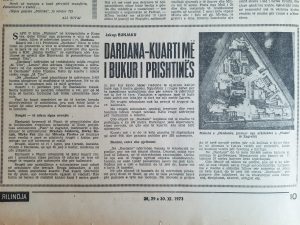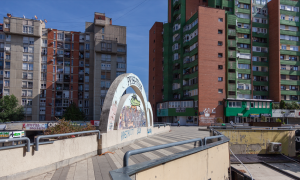At the end of November 1973, Jakup Bunjaku found himself in the office of the then mayor of Prishtina, Nazmi Mustafa. “It would be good if the neighborhoods had Albanian names,” Bunjaku had told the mayor, who then asked him: “Do you have any ideas?”
Bunjaku, a journalist for the Prishtina-based Rilindja newspaper who covered urban development and infrastructure, had a clear idea. He wanted the neighborhood to be named Dardana, stemming from the Albanian word “dardha,” meaning pear. Bunjaku wanted to avoid possible interpretations that the name was related to the Kingdom of Dardania, which given the circumstances of the time, could have meant his idea was not accepted.
Prishtina and the rest of Kosovo began to enjoy greater economic investments at the beginning of the 70s, having been ignored until then by the central institutions of Yugoslavia. The state began to construct a new neighborhood in Prishtina which they planned to name Trougao, meaning “triangle” in Serbian, due to its triangular shape if seen from above.
Without a second thought, Mayor Mustafa, whose office doors were always open for Bunjaku, instructed him to publish an article about the new neighborhood, calling it Dardana.
“I told the editor, Mustafa Rushiti, that the Mayor had agreed with my idea. He hesitated at first, but allowed the proposal to be published,” said Bunjaku, recalling November 27, 1973. The day after, which also happened to be Albanian Flag Day, page ten of Rilindja contained an article titled “Dardana – the most beautiful quarter of Prishtina.”
Following a slight alteration, the neighborhood’s name became Dardania.
A long road to the classroom
Bunjaku, a journalist and teacher, still lives in the neighborhood which he named. Almost 88 years old, he rarely leaves the first floor of the four-story building, nestled in an alley that leads to the bus station. When the weather is good, he goes out into his small garden and tends to the flowers.
When he is not taking care of the yard in the neighborhood that he loves so much, he reads and reviews an ABC book. This, he wrote as an alternative to the official curriculum but has never found funding to publish.
This is not the first ABC book he has compiled. He also wrote a textbook for Albanian schools in Yugoslavia, but it was never published.
“I had it all ready. Then I was told that they [the educational institutions of the time] decided to use Albania’s ABC book, but they would remove the photo of Enver Hoxha. I was very happy that it was coming from Albania, so I didn’t make a fuss,” said Bunjaku, laughing as he told this story.
He often dealt with textbooks and had never planned to be a journalist. He finished primary school at the beginning of the 40s, in the village of Poliçkë in Kamenica. He began his studies a few kilometers away in Hogosht and continued them in Prizren.
He loved music, nurturing his love for it by secretly listening to the exercises at the High School of Music in Prizren. “I used to listen to the student’s musical exercises from outside the school,” he said. One day, the school guard sent him to the director Lorenc Antoni, to “see if he had an ear for music.”
“‘Bravo’ he told me, ‘you have a talent for music.’” When he found out that I was from Kamenica, he told me: ‘You, good boy, will come to our school as soon as you finish the lower gymnasium. You will be the first student from Anamorava to become a music teacher,” said Bunjaku.
His dream of going to music school did not come to fruition. The municipal scholarship, which would have enabled him to study music, went to someone else.
There were no other municipal scholarships in Kamenica, so Bunjaku had to find another way, a new direction.
He decided to enroll at the Prishtina Normal School, which was a teacher training school, equivalent to university level today. Someone suggested that he go to Prishtina because the municipality was giving out scholarships.
“I walked 80 kilometers. When I reached the Great Mosque in Prishtina I fainted from exhaustion. They sent me to hospital, where it took me 10 days to recover,” Bunjaku remembered. After a meeting with Ymer Pula, a political leader of the time, he secured a place and accommodation at the normal school.
His time at the normal school was not easy for him and his Albanian peers, especially after 1956. In the winter of that year, the Yugoslav government confiscated weapons from the Albanian population, which escalated into a proposal that educational institutions teach only in Serbian.
Ali Hadri and Hasan Mekuli were teachers at Bunjaku’s high school and openly opposed this proposal. Ultimately, the government’s plan to remove Albanian from schools failed. In the following years, the Albanian population campaigned extensively for their right to an Albanian language education
From the classroom to the newsroom
In 1959, Bunjaku graduated from Prishtina Normal School. In the absence of other career options, graduation often meant the beginning of teaching work. This was the case for Bunjaku, who returned to rural Kosovo, this time as a teacher. Rather than in his hometown, Bunjaku found a post in the village of Pozharan, Gjilan, which students from surrounding villages also attended.
“I covered music, physical education and art,” he said. Having played Bunjaku first violin in the school orchestra of Prishtina Normal school, Bunjaku expressed a particular joy that he was able to teach music.
He was never satisfied with the knowledge that he would pass on to new generations and constantly sought to learn more.
“I attended the seminar for music education teachers from Serbia, Kosovo and Vojvodina, which was held in Kruševac. The Slovak lecturer Arnold Vlasak saw that I was very interested and asked how many students I taught, and proceeded to send me a free copy of his book for every student,” said Bunjaku. He had transformed the school where he taught into the best for music in the area and his students’ performances were recorded by Radio Belgrade and Radio Prishtina.
Even in art, he made sure to offer students new approaches. He learned from pedagogical articles written by Croatian teachers, which he read in a monthly magazine published in Osijek. This magazine contained articles about mosaics, traditional dowry ornaments and carpets. Bunjaku organized exhibitions with his students in order to display their artwork.
In the 1962-63 school year, he left the village to work in a primary school in Ferizaj, which is now known as Gjon Sereqi. There were great challenges in the education system at that time, such as a lack of equipment and infrastructural problems. Bunjaku did not spare any criticism. He constantly delivered reports about the state of education to the editorial office of the Rilindja newspaper.
In 1965, Rilindja opened a competition for correspondents from the largest regional centers of Kosovo. This competition had not enticed him, but someone thought Bunjaku would be a good fit.
“At that time, Vehap Shita, culture editor at Rilindja had mentioned my name. He said a teacher from Ferizaj often writes to me about problems in education. They called me to the newsroom and told me that I could start working as a correspondent from Ferizaj,” said Bunjaku.
Back then, a journalist’s salary was higher than a teacher’s. In search of a better life, he chose to pursue journalism.
His first task was to write a summary of weekly occurrences in Ferizaj, which was published on one page of the newspaper every Friday. Bunjaku’s page was positively received by Sedat Dida, a former editor.
Bunjaku used to read newspapers from Belgrade in order to understand his new field of work and to learn how to write professional articles. Not long after, he was writing most of the articles for Rilindja by himself. Throughout the week, he covered events and meetings of the Municipal Committee of Ferizaj and voluntarily contributed as a journalist to Radio Ferizaj, also guiding young journalists such as Rexhep Rifati and Mehmet Emërllahu. The former soon became a correspondent for Rilindja.
At the beginning of the 70s Bunjaku set off for Prishtina, which remains his home to this day.
“Chief Jusuf Kelmendi gave me permission to start work after I found an apartment to rent. After two weeks of searching, I could barely find an apartment in the old part of the city,” said Bunjaku. He was then assigned to cover events in the capital, which were many, especially considering the period Prishtina was going through.
At that time, Prishtina had begun to transform into a modern city. These many infrastructural developments soon became the subject of Bunjaku’s journalism.
Albanian names for Prishtina’s neighborhoods
The 70s saw the erection of many of Prishtina’s most iconic buildings, such as the Grand Hotel, the Rilindja Tower, the National Library, the Student Canteen, the University of Prishtina Campus, the Palace of Youth and Sports, the Central Bank and the Ulpiana and Dardania neighborhoods.
Bunjaku brought these developments to the public through newspaper articles. He was inspired to write about architecture by the Naš Dom magazine, meaning “our home” in Serbian.
However, he was worried about the Serbian and Turkish naming of the neighborhoods in Prishtina, which according to him was due to the influence of Serbian architects and officials of the time.
“The new neighborhoods that had been built in the meantime were Aktash and Tashlijja, named in Turkish and Dragodan and Voja Janković, named in Serbian,” he said.
One of the only neighborhoods with an Albanian name was Ulpiana, designed by the architect Bashkim Fehmiu. According to Bunjaku, the Albanian name of this neighborhood was only allowed because the Serbs thought that the ancient city of Ulpiana had nothing to do with Albanian history.
Bunjaku’s influence in tandem with the determination of the former Mayor Nazmi Mustafa, who had previously been director of the Goleshi Mine and the Obliq Mine, came up with the name Dardana, for the neighborhood now known as Dardania.
After he had proposed the name and published the article in Rilindja, another task awaited Bujnak. The former mayor invited him to go and justify the name to the commission for naming squares, streets, schools and neighborhoods.
“The time has come for new neighborhoods to have Albanian names,” said Bunjaku to the commission led by his professor of pedagogy at the normal school, Jusuf Shushka. He smiled, remembering the joy he had felt that an Albanian name was going through the approval process.
After three months of deliberations about the name in local meetings, the proposal reached the Municipal Assembly.
“The person who suggested it [in the Assembly], proposed the name as Dardania. A Serb from Obliq stood up and said it wouldn’t work, we are naming it ‘Tito’. Then Nazmi Mustafa replied, ‘Tito’s name has gathered dust in Obiliq, and now you are telling me to name a neighborhood after him? The name Tito is for a city’, and so it went into the minutes as ‘Dardania’ and not ‘Dardana,'” remembered Bunjaku.
Dardania’s architects were from the Plan architectural design organization from Zagreb: Dražen Janković, Darko Kožjak, Mirko Pak and Milena Fischer. According to Bunjaku’s article in Rilindja, they won the design competition because their plan for the streets was the best, carefully designating space for vehicles and for pedestrians. The design was a success and you can walk easily through Dardania today.
When the team of architects had arrived from Zagreb to Prishtina, naturally they met Bunjaku. “We had lunch at Bozhur,” he said.
On September 16, 1974, almost a year after the meeting where Bunjaku proposed the name, the foundation stone was laid for the neighborhood. Some of the participants were the mayor of Prishtina Nazmi Mustafa, the rector of the University of Prishtina, Idriz Ajeti and Vehbi Orana, who ran the Ramiz Sadiku company. Bunjaku followed Dardania’s construction step by step and also found his home there.
There were nearly 5,000 apartments which were planned to be built by the end of the year and they were completed at different times. Bunjaku’s articles covered the progress of the construction as well as the discrimination he saw in how the apartments were allocated.
“The workers got the smallest apartments [compared to the leaders] even though they had more family members. The workers’ councils decided this according to the directors’ wishes,” said Bunjaku, who does not remember exact dates after all this time.
From journalism to crime reporting
In 1982 Bunjaku left his job at Rilindja after almost two decades and joined a newspaper belonging to the Kosovatrans company, which managed bus routes in Kosovo. The size of enterprises during the socialist period allowed them to have a periodical of their own.
However, his work there did not last nearly as long. The 1989 suppression of Kosovo’s autonomy in the Yugoslav Federation was followed by a mass firing of Albanian employees from their workplaces. Bunjaku was one of around 150,000 Albanians who lost their jobs in the early 1990s.
During this time, state violence against the Albanian population began to increase. In order to document cases of violence, Bunjaku joined the Council for the Protection of Human Rights and Freedoms (KMDLNj).
Bunajku was in charge of gathering reports from municipalities in Kosovo, from where reporters sent data on crimes committed against Albanians. Bunjaku compiled the most serious cases into his own report, which he sent to embassies and international organizations. “This is how we told the world what was happening in Kosovo,” said Bunjaku.
After the last war in Kosovo he retired. His name no longer appeared in newspapers as a journalist. It can be found in the archives, when flipping through the dusty pages of newspapers that are now half a century old. Once upon a time, there was no building that was planned or built without Bunjaku.





